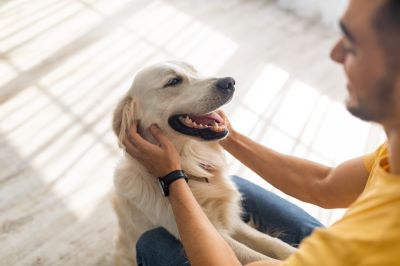Teaching your dog to sit

When it comes to training your dog, teaching them to ‘sit’ is probably the first thing on the list. This is an essential command for your dog to learn, because it will help you to keep them under control in many different situations, from meal times to walks outside.
First steps
First, you need your dog to be relaxed and focused, so choose a time when they’re neither tired or overly excited and find a quiet and distraction-free spot to begin training. This could be a room in your house or a fenced-off area in your garden.
Get your dogs attention
Next, get your dog's attention by using their name or a clicker. Clicker training is a popular method for teaching dogs new commands and can be a useful tool to have up your sleeve. Once you have your dog's attention, hold a treat in your hand and let them smell it. Slowly raise the treat above their head, encouraging them to follow it with their nose.
Rely on natural instinct
As your dog follows the treat, their natural instinct will be to lift their head and raise their paws off the ground. This is the perfect time to introduce the command word "sit". Once your dog’s bottom touches the ground, say "sit" and give them the treat.
Repeat
Repeat this process several times, gradually reducing the height of the treat until your dog is sitting without needing to raise their paws off the ground. Over time, your dog will learn to associate the command word "sit" with the action of sitting down.
Be patient
It's important to remember that training your dog to sit takes patience and consistency. Some dogs may pick up the command quickly, while others may take longer. But don’t lose heart! Keep your training sessions short and positive and reward your dog with praise and treats when they get it right.
Signal and command
Another useful tip when teaching your dog to sit is to use a hand signal and the command word. This can help to reinforce the action and make it easier for your dog to understand what you want them to do. A simple hand signal for ‘sit’ is to hold your hand up, palm facing outwards.
Gaining confidence
If your dog is struggling to pick up the command, try breaking it down into smaller steps. For example, you could reward your dog for simply lifting their head or lowering their body, before progressing to the full ‘sit’ command. This will help build their confidence, and it will make the training process more enjoyable and less frustrating for both of you.
End on a positive note
Remember to always end your training sessions on a positive note, even if your dog hasn't quite got the hang of it yet. Shower them with lots of praise and give them a treat, and then move on to something else.
It may not feel like it at first, but your dog will soon sit on your command without any fuss or need for a treat. And each time they do, you can enjoy that warm fuzzy feeling, knowing that they understand how to do that because you took the time to teach them.
